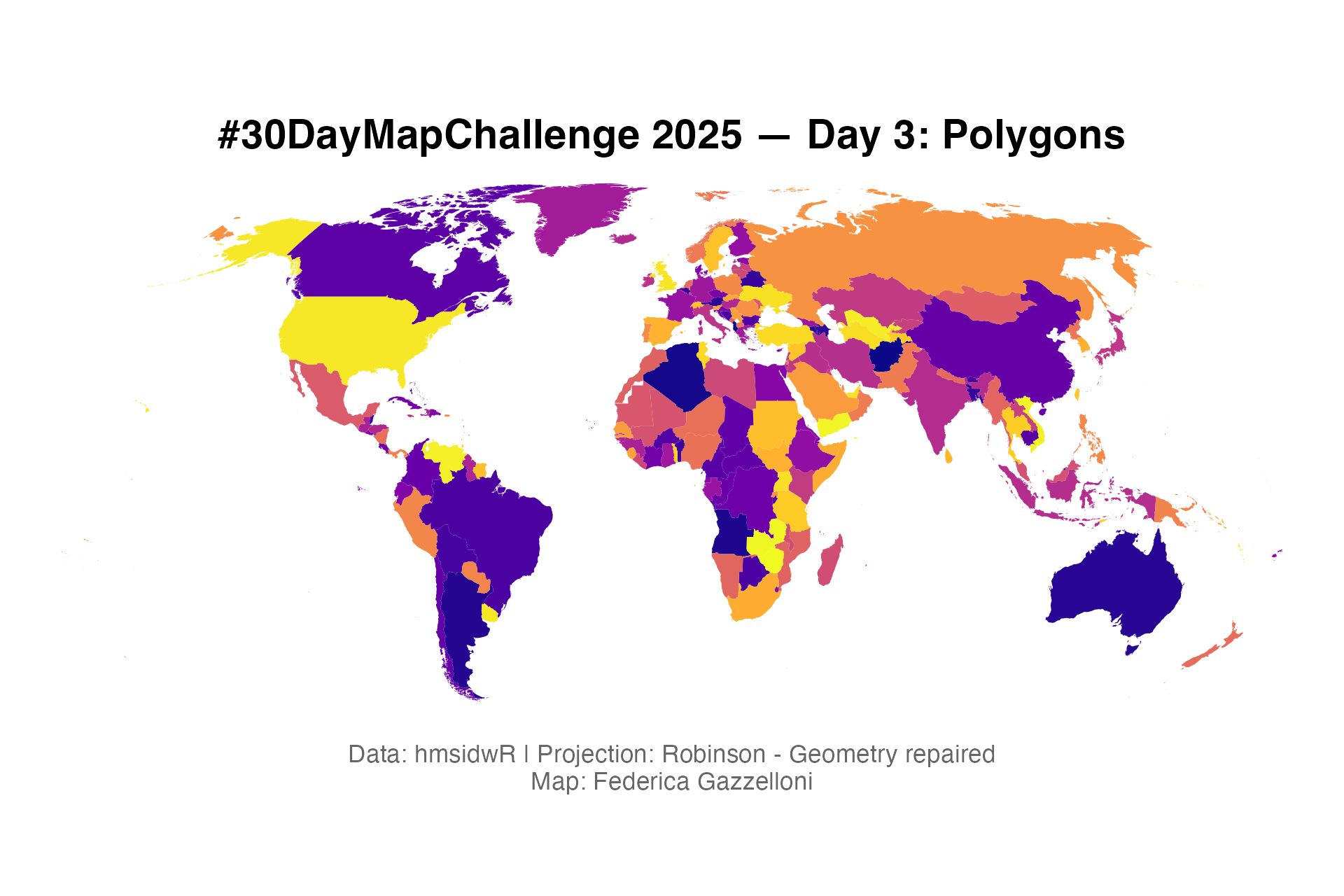
Overview
Data for this challenge comes from the hmsidwR package, which includes global polygon data for mapping disease burden (DALYs) worldwide.
Load Libraries and Data
data(idDALY_map_data)To gain more info about the data:
?idDALY_map_dataplot(idDALY_map_data)Working with Global Projections and Polygons
To plot the map’s polygons to work properly in a different global projection such as the Robinson projection, some preprocessing is needed.
When I first plotted the global polygons under Robinson projection, I noticed strange lines crossing Russia and the equator. These were caused by polygons that were invalid or crossed the ±180° meridian, a common issue in global datasets where countries span the dateline.
To fix this, I followed a few steps:
- Make sure the geometries are right with
st_make_valid(), this removes self-intersections and other inconsistencies.
# 1. Make valid (repairs self-intersections)
idDALY_clean <- st_make_valid(idDALY_map_data)- Split multipolygons into individual polygon parts using
st_cast(), ensuring that each island or country segment was treated separately.
- Wrapped polygons at the dateline with
st_wrap_dateline(), so that shapes crossing the ±180° longitude were properly split and would not draw straight lines across the map.
# 3. Split polygons that cross the dateline
idDALY_clean <- st_wrap_dateline(idDALY_clean, options = c("WRAPDATELINE=YES", "DATELINEOFFSET=180"))- Reprojected to Robinson with
st_transform(), so the data could be displayed correctly on a flat, visually pleasing projection.
# 4. Reproject to Robinson
idDALY_robin <- st_transform(idDALY_clean, "+proj=robin")- Assigned unique polygon IDs to maintain proper grouping in ggplot2.
# 5. Assign a unique polygon id for grouping
idDALY_robin <- idDALY_robin |>
mutate(poly_id = row_number())These steps removed the unwanted lines and allowed the polygons to render smoothly in any projection, giving a clean, accurate global map for the Day 3 challenge.
Finally, I plotted the cleaned and reprojected polygons:
# 6. Plot
ggplot(idDALY_robin) +
geom_sf(aes(fill = location_name,
group = poly_id),
show.legend = FALSE,
color = NA) +
coord_sf(crs = st_crs(idDALY_robin)) +
theme_void() +
scale_fill_viridis_d(option = "C") +
labs(title = "#30DayMapChallenge 2025 — Day 3: Polygons",
caption = "Data: hmsidwR | Projection: Robinson - Geometry repaired\nMap: Federica Gazzelloni") +
theme(plot.title = element_text(face = "bold", hjust = 0.5),
plot.caption = element_text(size = 8,
colour = "grey40", hjust = 0.5))ggsave("day3_polygons.png", height = 4, width = 6, dpi = 320)Explanation of the Issue with Polygons and Global Projections
Most global shapefiles (like those used in {hmsidwR}) are stored in longitude/latitude (EPSG:4326), so the world is represented as coordinates ranging from -180° to +180°.
But here’s the catch:
- Countries like Russia, USA (Alaska), and Fiji span across the antimeridian (the ±180° meridian).
- In raw coordinate form, these countries can have polygons whose edges go from +179° → -179°, which looks fine on a globe but breaks on a flat map.
- When you reproject such data (for example, to the Robinson projection), the reprojection algorithm doesn’t wrap those edges, it literally draws a straight line between +179° and -179°, which slices across the map (through the Pacific, or even across the equator).